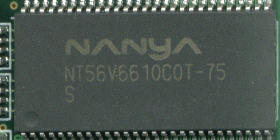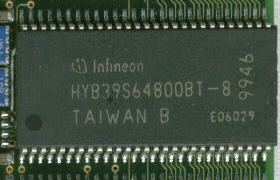A Tale Of Two Mushkins: PC133 CAS3 VS. PC100 CAS2
There's nothing
better than a good fight and SDRAM makes for particularly good ammunition.
In automotive circles, Chevy vs. Ford always makes the interested parties'
blood boil, but what about a Chevy vs. Chevy dukem out? How does Mushkin stand
up against itself? For that matter, what is CAS and what does 2 or 3 designate?
For this comparison, I've nabbed two 128 MB strips of Mushkin's DIMM type
RAM and benchmarked the results for your perusal.
|
Factory
Specifications
|
The
Strips
|
|
PC133
CAS3
- 7.5 nS Nanya
Chips
- 16 x 8MB
(128MB)
- Lifetime
Mushkin Warranty
PC100
CAS2
- 8 nS Infineon
Chips
- 16 x 8MB
(128MB)
- Lifetime
Mushkin Warranty
|
|
The Case Of CAS
CAS literally
means column address strobe, which is fancy terminology
for how fast the RAM in your precious box can process temporary information.
The common designations for SDRAM has been 2 and 3. The 2 signifies two cycles
and the 3 signifies 3 cycles. Because more cycles takes more time, the lower
your CAS setting, the quicker your RAM is at a particular FSB.
PC "XXX"
Speeds
PC100 theoretically
gives rise to a timing spec of 10 nS. A nS is a short period indeed, being
1E-9 or 0.000000001 seconds. Fast, eh? An easy method of calculating the nS
required to meet a certain MHz requirement is to use the 1000 (MHz-nS) rule.
For example: 1000 (MHz-nS) / 7.5 nS = 133 MHz (rounded from 133.33). So if
somebody tells you they have 5 nS RAM, that would imply a speed of 200 MHz.
The vast majority of the time, this one or two digit nS rating can be easily
found by closely examining the chip at hand.
The Test
Rig
The motherboard of choice
was the Abit BE6-II combined with Maxtor's excellent 30.7GB
ATA66 HD. Alas, all I had on hand, other than the ubiquitous TNT2 Ultra
AGP card, was a tired old 1 MB PCI video card. This served to stabilize the
setup and offset the very unstable AGP overclocking speeds of over 91 MHz,
which the TNT2 Ultra definitely did not like. At 137 MHz, the PCI speed is
only 2.7% out of spec, which is usually well within manufacturer's tolerances.
Mushkin
PC133 CAS3
 Since
this is rated for 133 MHz FSB, it should be stable at least at that frequency.
As the benchmarks revealed, this Nanya chipped strip does an excellent job
all the way up to the 650E Coppermine's limit of 137 MHz FSB. As I suspected
even before AnandTech's
PC133 roundup was published, this strip had more to give. Under the right
conditions, it tops out at 146 MHz FSB if and only if your video card and
processor chip are fully stable at that high speed. Interestingly enough,
this CAS3 sample would run at CAS2; however, a lowering of the FSB all the
way down to 99 MHz was required. At 100 MHz FSB, the computer wouldn't even
boot let alone run stably. Whoever Nanya is, they make a solid, stable, high
performing SDRAM chip.
Since
this is rated for 133 MHz FSB, it should be stable at least at that frequency.
As the benchmarks revealed, this Nanya chipped strip does an excellent job
all the way up to the 650E Coppermine's limit of 137 MHz FSB. As I suspected
even before AnandTech's
PC133 roundup was published, this strip had more to give. Under the right
conditions, it tops out at 146 MHz FSB if and only if your video card and
processor chip are fully stable at that high speed. Interestingly enough,
this CAS3 sample would run at CAS2; however, a lowering of the FSB all the
way down to 99 MHz was required. At 100 MHz FSB, the computer wouldn't even
boot let alone run stably. Whoever Nanya is, they make a solid, stable, high
performing SDRAM chip.
Mushkin
PC100 CAS2
 At
the time of purchase, this CAS2 sample cost slightly more than
the faster FSB rated Nanya type. Is Mushkin pulling a fast one here? Not at
all. Upon closer inspection, I spied the 8 nS rating, which would indicate
that this sample would be stable at 125 MHz although not necessarily at CAS2.
The tests show full stability at CAS2 at up to a 123 MHz FSB. CAS3 tests reached
(again) the limits of the 650E at 137 MHz. This was much more performance
than I ever expected from a PC100 rated strip.
At
the time of purchase, this CAS2 sample cost slightly more than
the faster FSB rated Nanya type. Is Mushkin pulling a fast one here? Not at
all. Upon closer inspection, I spied the 8 nS rating, which would indicate
that this sample would be stable at 125 MHz although not necessarily at CAS2.
The tests show full stability at CAS2 at up to a 123 MHz FSB. CAS3 tests reached
(again) the limits of the 650E at 137 MHz. This was much more performance
than I ever expected from a PC100 rated strip.
